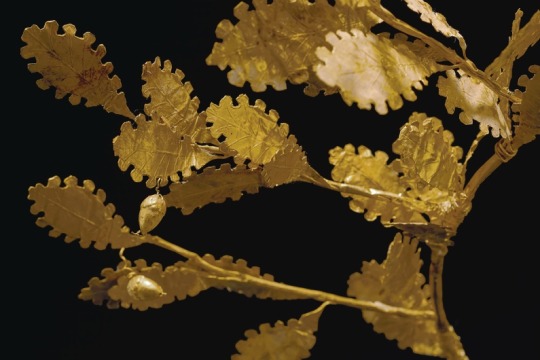#LATE CLASSICAL TO EARLY HELLENISTIC PERIOD CIRCA 4TH-3RD CENTURY B.C.
Photo

A FRAGMENTARY GREEK GOLD OAK WREATH
LATE CLASSICAL TO EARLY HELLENISTIC PERIOD, CIRCA 4TH-3RD CENTURY B.C.
Each: 1 3/4 in. (4.4 cm.) long.
#A FRAGMENTARY GREEK GOLD OAK WREATH#LATE CLASSICAL TO EARLY HELLENISTIC PERIOD CIRCA 4TH-3RD CENTURY B.C.#gold#jewelry#ancient artifacts#archeology#archeolgst#history#history news#ancient history#ancient culture#ancient civilizations#ancient greece#greek history#greek art
23 notes
·
View notes
Photo


A GREEK GOLD OAK WREATH
LATE CLASSICAL TO EARLY HELLENISTIC PERIOD, CIRCA 4TH-3RD CENTURY B.C.
17 ½ in. (44.4 cm.) wide.
In ancient Greece, foliate wreaths fashioned from gold, mimicking natural forms such as laurel, myrtle, olive, ivy, and, as here, oak, were given as prizes, worn in processions or in the symposia, dedicated at sanctuaries and buried with the dead. Sanctuary dedications are mentioned in temple treasury lists from as early as the 5th century B.C., but surviving examples are few prior to the 4th century B.C. The meaning of the different plant species employed for these wreaths is uncertain, but in the case of oak, there is at least a clear association with Zeus.
Elaborate gold oak wreaths have been found in the Royal tombs at Vergina, including one placed within the gold larnax thought to have enclosed the remains of Philip II, father of Alexander the Great, and another found in situ on the shoulders of a silver funerary hydria in the nearby so-called “Prince’s Tomb”. The large amount of gold that flowed into Macedonia and Greece following Alexander’s eastern campaigns led to a dramatic increase in jewelry production, and high quality works were now accessible to wider strata of society. As P. Adams-Veleni notes. “Indeed, rather than a privilege of the gods, such wreaths were common among wealthy mortals, whom they accompanied after death to the eternal symposium in the beyond.”
Oak wreaths dated to the later 4th century B.C. have been found throughout the Hellenistic world, east and west. Wreaths are also to be found on depictions of victorious athletes, including statues, coins and gems, although depending on the scale of the image, it is not always possible to identify the type of wreath intended.
The present example is composed of cut-out sheet-gold leaves, 104 in total, each on spiral-twisted wire and joined to ten stems radiating outward from a central ring. Four acorns are preserved on four of the stems.
#A GREEK GOLD OAK WREATH#LATE CLASSICAL TO EARLY HELLENISTIC PERIOD CIRCA 4TH-3RD CENTURY B.C.#gold#gold jewelry#ancient gold jewelry#ancient artifacts#history#history news#ancient history#ancient culture#ancient civilizations#ancient greece#greek history#greek gods#zeus
27 notes
·
View notes